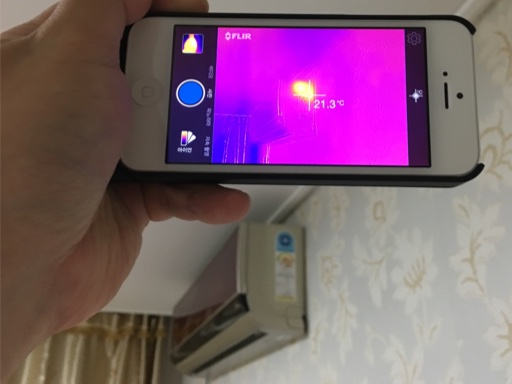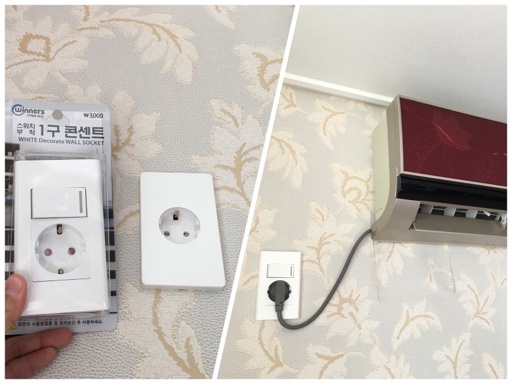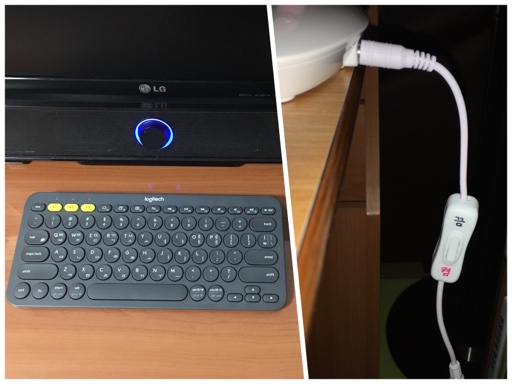Tracking down electricity draw (Part 3)
Posted by Wesley on
Thermal imaging shows the air conditioner's standby power turning into heat
As the hunt for even more potential waste of power continued, I brought in the help of thermal imaging technology. By scanning each place with a thermographic camera attached to an iPhone (FLIR One; I'll write about this later) I can find any hot or cold spots that seem to be out of place.
One of such "hot" spots I found was on the side of an air conditioning unit. It wasn't being used, but standby power drawn from the wall outlet was slightly heating up the control circuit and was readily visible via thermal images. I could just pull the plug until summer, but I decided to take a step further.

Installing a wall socket with a switch so the air conditioner won't use standby power
I replaced the default wall outlet with the one that had an integrated switch. This way, I could cut the power from the outlet with a switch when the air conditioner isn't in use, instead of having to pull the plug. Not only would this be simple to operate, it would avoid the mechanical wear. I should have done this ages ago.
As part of my ongoing data collection, I then tried to measure how much power the air conditioners in the house would consume while trying to cool the house. Sadly, the rooms were not hot enough for them to start cooling the air. I'll have to check them out again when summer comes.

More power savings - be more efficient or add a power switch
Elsewhere, more optimizations were underway. The Apple USB keyboard I've been using for about 8 years was responsible for sipping 0.7W (or about 140mA on 5V) constantly, which seemed to be rather inefficient. Perhaps it was due to its integrated USB hub. Still, knowing that Bluetooth keyboards are far more efficient than this, I decided to have it replaced with Logitech K380 instead. According to its specs, it can last up to 2 years with two AAA batteries, so it effectively kills that 0.7W from the equation.
Also, I got around to replacing the fluorescent light desk lamp with LED type. Just like when I replaced the ceiling light fixtures, the energy savings were noticeable, as the table at the end of this post will show. One problem was that the new one was using a touch switch like the old one, and had standby power nearly as bad. Luckily, installing a switch between the power adapter and the lamp solved this problem. The desk lamp is now more energy conscious both on and off.
Finally, here are further power consumption data I've gathered since my last post. I was able to identify more back-end systems built into the house and measure them, but even after that I was left with about 10W of constant power consumption happening in the background. I suppose this is the price of living in a modern apartment.
| Type | Name | Off | Idle | Active | Rated |
|---|---|---|---|---|---|
| Back-End System | |||||
| Base Load | (Switches, Controls, etc.) | - | 10.6 | - | - |
| Wall Pad | Samsung SDS SHN-8810 | - | 6.2 | 8.4 | - |
| Fire Safety | Hankook Fire HKC-500, etc.1 | - | 6.6 | - | 140.0 |
| Kitchen | |||||
| Microwave Oven | Daewoo Elec. KOR-6C6K | - | 1.3 | 933.0 | 1020 |
| Electric Oven | Kitchenart KT-1800H | 0.0 | - | 12502 | 1400 |
| 2-Slot Toaster | Braun HT400 (4120) | 0.0 | - | 834.4 | 900.0 |
| 684L Refrigerator | Samsung Zipel SRT686UTHJ | - | 3.0 | 88.63 | 150.0 |
| (Peak Consumption) | 140.4 | ||||
| Hygiene | |||||
| 15L Washing Machine | LG Smart Drum T15MA | 0.2 | 3.9 | 74.54 | 400.0 |
| (Peak Consumption) | 236.0 | ||||
| 510W Vaccum | Samsung Stealth VC-B935Z | - | 0.7 | 994.0 | 1100 |
| 500W Vacuum | Samsung Ssen VC-PW620 | - | 0.7 | 936.0 | 1050 |
| Movable Lighting | |||||
| CFL Desk Lamp | Samjung SS-730 | - | 0.6 | 17.4 | 21.0 |
| LED Desk Lamp | BuyBeam BL-628 | 0.05 | 0.4 | 8.06 | 8.0 |
[ Terminologies & Explanations ]
Off: The device is turned off with its power switch, or just connected to the power and not showing any signs of operation. Most of the cases, it's in standby mode.
Idle: You can tell that the device is turned on (e.g. power light or screen is on, immediately responds to commands, etc.), but isn't doing anything.
Active: The device is actively working to do what it's supposed to do (e.g. recording a TV show).
Rated: How much the power supply or the device is rated to draw electricity at maximum.
1. The entire system is composed of the following: fire extinguisher (HKF-310), receiver (HKC-500), controller (HKR-300), gas detector (HKD-400), nozzle / temperature sensor (HKT-300 & HKN-200), and electronic gas valve (HKS-360E).
2. Obtained when both top and bottom heating elements are turned on. Top one consumes 660W and bottom one consumes 610W when turned on individually, but for some reason they don't consume 1270W together.
3. Obtained during stabilized cooling cycle. The power draw initially peaks, then settles down in a span of a few minutes. Of course, the equipment cycles through active and idle, so the average consumption during the course of a day is lower than this.
4. Calculated from a typical laundry session consuming 82Wh in 1.1 hours (82 / 1.1 = 74.5).
5. This is how much the power adapter draws when the main unit is disconnected. By installing a switch on the power cable, idle power can be cut off.
6. Obtained with the maximum brightness setting. Middle and low settings consume 3.4W and 1.1W, respectively.